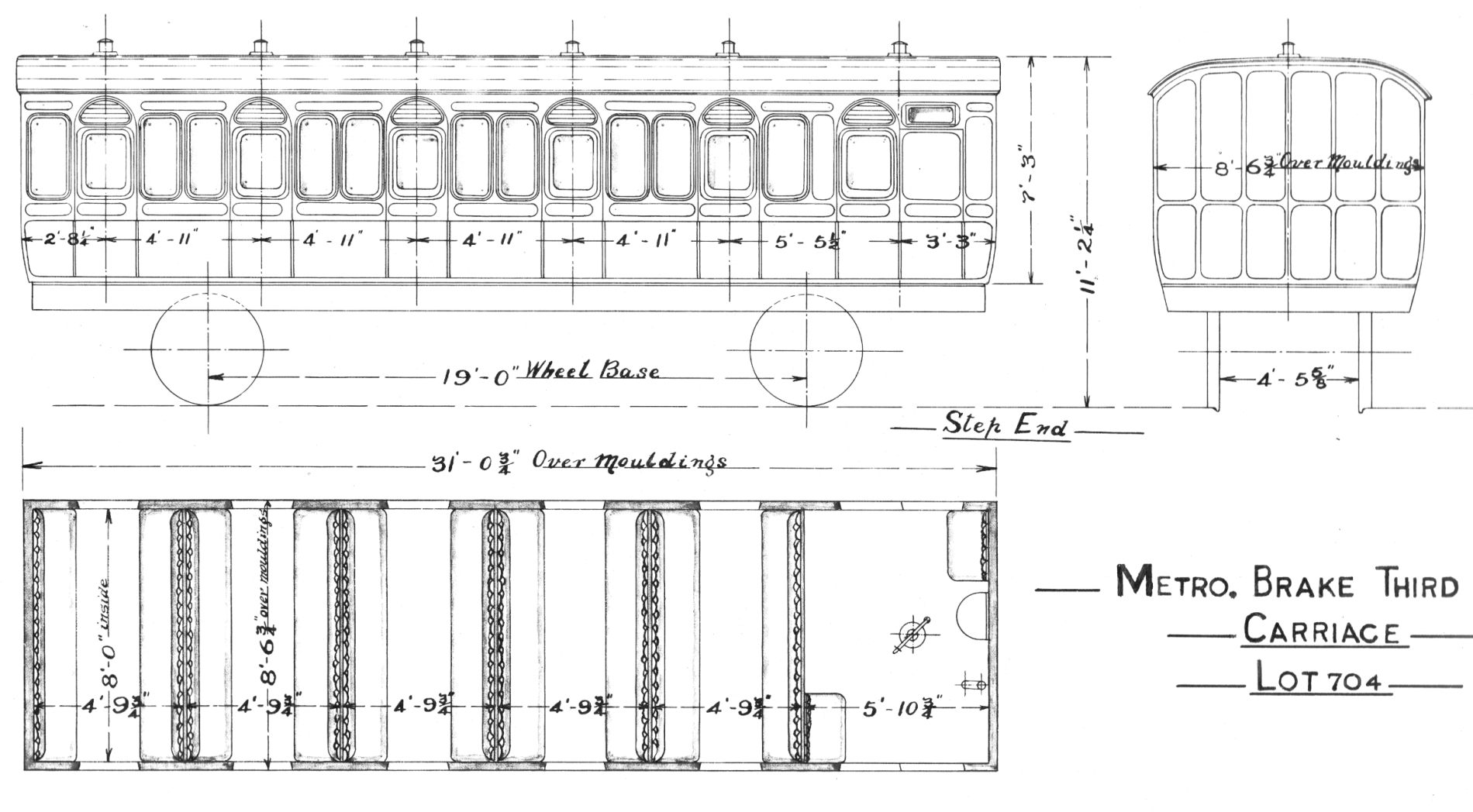|
Following on from the experimental set of coaches designed specifically for the London Metropolitan areas in 1884, in 1887 Dean went on to build 2 trains of a new style, Lewis style LE4MW. They featured
the same style of doors with a round tops and kept to the same 8' 6¾"
width. However, the roof was changed to a 3 arc shape which had just been introduced on one lot of saloon coaches and a lot of brake thirds. Instead of the tall windows right up to the cornice,
the compartment windows had a 4" tall eaves panel above, which became
unique to the metropolitain coaches and a couple of transitional styles. They also had gas lighting which was still unusual at the time as most other coaches had oil lights.
Each 9 coach train was formed with a brake second, 2 second class coaches, 2 first class coaches, 3 third class coaches and a brake third. The first and second class coaches had 4 compartments whilst the third class coaches had 5 compartments. Both brake seconds and one of the brake thirds had 3 compartments and the other brake third had 4 passenger compartments. The coaches were all 26' long except the second class coaches which were 24' long. The designs were later given diagrams R4, S16, S18, T7, T8. The 4 compartment brake third did not receive a diagram. These trains initally ran on the Middle Circle service in London. Just a couple of months after these trains were delivered 6 more trains for the Middle Circle service were ordered and were completed over the following year. Four trains were built with one second class coach and 2 had none excep tthe brake second! I think that there must have been surplus second class S4s around to make up the required number of second class coaches in these trains. The brake coaches differed from the previous designs. Both only had 3 compartments and both had the double doors in the middle of the guard's compartment with a pair of wood panels eitherside. When diagrams were issued 20+ years later the brake second coaches were given diagram T9, but the brake thirds shared T8 with the earlier coaches. The first class coaches were also different to the previous design and were given diagram R5. The differences could only be distinguished by using a tape measure. There was ⅛" difference in compartment width between the designs! Later in 1889 a futher 4 trains were built with one second class coach, bringing the total up to: | ||||
| 1 train formed | T7 (2nd), S16 x2, R4 x2, S18 x3, Brake Third | |||
| 1 train formed | T7 (2nd), S16 x2, R4 x2, S18 x3, T8 (3rd) | |||
| 2 trains formed | T9 (2nd), R5 x2, S18 x3, T8 (3rd) | |||
| 8 trains formed | T9 (2nd), S16, R5 x2, S18 x3, T8 (3rd) | |||
| There then was a 4 year break in building Metropolitan coaches until 1893 when 12 S18s were built to supplement the Middle Circle trains. The difference this time was that they were fitted out for second class passengers. 1893 also saw the introduction of a new design of brake coach which later became diagram T17. Two were built, one as a third class coach and the other as a second class coach, both coaches were 2' longer at 28' long and both coaches featured 5' wide compartments which had up until now been the standard third class width. At the same time 4 first class coaches, 3 second class coaches and a third were built and formed as Main Line and City No.7 Train. This made a rather odd formation: | ||||
| Main Line & City No.7 | T17 (2nd), S18 (2nd) x 3, R5 x3, S18 (3rd), T17 (3rd) | |||
|
however there is evidence to suggest that this set remained together until at least 1905 as they all recieved steam heating in December 1903 and Incandecent light fittings in June 1905. One of the seconds was
converted to a third in December 1903 and appears to have remained in the set.
Also ordered at the same time in 1893 and outshopped in December 1893 were 6 trains for the Hammersmith and City line. These trains were formed of 4 new designs. The first class coaches were like the previous R4 and R5 designs, but 1' shorter; these became diagram R3. Similarly the second and third class coaches were like the S18 but 1' shorter; these became diagram S17. There was a new 28' long composite coach with 2 first class and 3 third class compartments which became diagram U6 and a new brake coach with 5 compartments, secord or third class, and a small guard's compartment. The brake third class coaches became diagram T60 and the second class were T59. These were 31' long and had 4'9 wide compartments. These trains really had high density seating! | ||||
| Hammersmith & City | T59 (2nd), S17 (2nd) x2, R3, U6, S17 (3rd) x3, T60 (3rd) | |||
| A 7th Hammersmith and City train was ordered as an afterthought and was delivered in February 1894. Ordered at the same time was another train with the Middle Circle formation although its use is not recorded in the lot register. | ||||
| Middle Circle train ? | T9 (2nd), S18 (2nd) x2, R5 x2, S18 (3rd) x3, T8 (3rd) | |||
|
It appears that this train stayed together until at least 1904 when 5 of the 9 coaches are recorded as Birmingham Local No.3. Any allocations for the other 4 coaches have been erased from the registers due
to the numbers being reused.
In 1895 another Middle Circle train was built, but this time it was formed with T17 and S18 so that it was the same formation as Main Line & City train No.7. Between 1895 and 1897 6 more Middle Circle trains were built, but they were formed with S17, T59, T60 and U6 so that they were the same as Hammersmith & City trains. In 1898 7 City Trains were built to the same formation. The final LE4MW coach built was 2695. It had suffered significant damage in an accident at Paddington and required a replacement body in 1898. This is the total list of coaches built as they were in their as built formations: | ||||
| 1 trains | T7 (2nd), S16 (2nd) x2, S18 (2nd), R4 x2, S18 x3, Brake third | Built 1887 | ||
| 1 trains | T7 (2nd), S16 (2nd) x2, S18 (2nd), R4 x2, S18 x3, T8 (3rd) | Built 1887 | ||
| 2 trains | T9 (2nd), S18 (2nd), R5 x2, S18 x3, T8 (3rd) | Built 1889 | ||
| 8 trains | T9 (2nd), S16 (2nd), S18 (2nd), R5 x2, S18 x3, T8 (3rd) | Built 1889 | ||
| 1 train | T17 (2nd), S18 (2nd) x 2, R5 x3, S18 (3rd) x2, T17 (3rd) | Built 1893 | ||
| 1 train | T9 (2nd), S18 (2nd) x2, R5 x2, S18 (3rd) x3, T8 (3rd) | Built 1894 | ||
| 1 train | T17 (2nd), S18 (2nd) x 3, R5 x3, S18 (3rd), T17 (3rd) | Built 1895 | ||
| 20 trains | T59 (2nd), S17 (2nd) x2, R3, U6, S17 (3rd) x3, T60 (3rd) | Built 1893 to 1898 | ||
| Total number of LE4MW Coaches built: | |||||||||||||||
| R3 | R4 | R5 | S16 | S17 | S18 | T7 | T8 | T9 | Brake Third - No diagram | T17 | T59 | T60 | U6 | Total | |
| 20 | 4 | 28 | 12 | 100 | 61 | 2 | 12 | 11 | 1 | 4 | 20 | 20 | 20 | 315 | |
| The Middle Circle services ended in 1905 when the GWR decided to stop the service. In 1906 the Hammersmith & City service was converted to electric. By 1910 there was only a requirement for 18 trains, which all operated the Main Line & City route from Reading and Windsor into the City of London: | ||||
| 5 trains | T59 (ex2nd), S17 (ex2nd) x2, R5 x3, S17 (3rd) x3, T60 | +2 spares | ||
| 3 trains | T59 (ex2nd), S17 (ex2nd) x2, R5 x3, S17 (3rd) x2, T60 | |||
| 8 trains | T59 (ex2nd), S17 (ex2nd), U6, R3, R3, U6, S17 (3rd) x3, T60 | |||
| In the above table I've assumed the most recent coaches were retained in London. I don't know which type of first class coaches were used in which formation. The remaining unrequired coaches, effectively the first
14 trains built minus their first class coaches, were dispersed around the GWR system.
However, these were not the first of the Metro coaches to leave London. As early as 1896 the first sets were being replaced by the new higher capacity sets. In 1896 some of the coaches of the second set to be built were recorded as being part of Birmingham Local No.4 and in 1897 the first train was similarly recorded as being Birmingham Local No.1. As sets left London three things happened to them; the second class compartments were converted to third class, the sets were shortened - usually to 7 or 8 coaches, some of the brake coaches had the van area increased by converting the adjacent compartment and a couple of S18s were converted to brake thirds. Over the years there were numerous other conversions which mainly relate to changes of class, all of which are listed below. One interesting conversion is that a set was converted to electric lighting in 1904. The coaches included T6 no.437, S18 nos.178 & 545, R4 no.171, S16 no.32 & 37, T8 no.2671. Most of which are probably in the photo below.
In 1920 the remaining London sets started to be displaced by the arrival of new toplight sets. With the last Metro set ceasing to be needed by 1926. | ||||
| Dimensions | ||||
| LE4MW | ||||
| Width over cornices | 9' ¼ | |||
| Width over body at waist | 8' 6¾ | |||
| Width over handles | 9' 0⅛ | |||
| Height to gutters | 9' 11½ | |||
| Height to top of roof | 11' 2¼ | |||
| Height over gas lights | 12' 1⅞ - Original 11' 10¼ - Gas Incandecent | |||
| Diagram | Dimensions Length x Width Wheelbase |
No. Built | Numbers | Conversions | Scrapping Dates | |
4 compartment first 4 wheels | 25' x 8'6 16' |
6 built in 1893 1 built in 1894 4 built in 1896 in 2 batches 5 built in 1897 in 2 batches 2 built in 1898 2 built in 1899 |
118 to 123 117 9, 10 50, 51 52, 53 133, 138, 139 140, 141 142, 143 |

|
8051, 8053, 8142 to Workmen's Third in 1932, 1933, 1932 respectively
118, 120, 122, 133, 140 to U1 all in 1907 |
8117 - 1931 8010, 8119, 8123, 8138, 8139, 8143 - 1932 8121 - 1933 8050, 8052 - 1934 8009, 8141 - 1938 |
4 compartment first 4 wheels | 26' x 8'6 17' |
4 built 1887 | 170, 171, 173, 174 | 
| 173 and 174 to composites U2 in 1897. | 8170 - 1932 8171 - 1933 |
4 compartment first 4 wheels | 26' x 8'6 17' cf R4 minor differences in compartment spacings |
12 built in 1888 4 in 1889 4 in 1889 3 built in 1893 2 built in 1894 3 built in 1895 |
12, 25, 62, 63, 65, 68, 70-72, 129, 132, 137 124, 134, 259, 285 128, 270, 271, 278 28 - 30 115, 116 31 - 33 |

|
136 (ex 285) to third Third in 1898
12, 25, 33, 62, 63, 65, 68, 70, 72, 115, 116, 127 (ex 278), 128, 129, 132, 134, 135 (ex 259), 137, 271 to composites U2 in 1896 - 1899, except 33 in 1907 8124, 8028 to 8030 to Workmen's Third in 1931 & 1933 |
8071 - 1932 8131 (ex 270) - 1933 8031, 8032 - 1936 |
4 compartment second later converted to third class
| 24' x 8'6" 15' |
4 built in 1887 8 built in 1889 in 3 lots | Second class numbers: 9, 11, 32, 35 14 to 17 19, 21 36, 39
270, 277, 278, 1455 193, 1449 197, 412 |

|
Renumbering | 412 - 1931 193, 269, 278, 1449, 1455 - 1932 186, 197, 270 - 1933 198, 205 - 1935 |
5 compartment second or third 4 wheels | 25' x 8'6" 16' |
Built as Second Class:
12 in 1893 2 in 1894 4 in 1896 4 in 1896 4 in 1897 6 in 1897/8 4 in 1898 4 in 1898 |
54 to 65 73, 74 85 to 88 93 to 96 97 to 100 106 to 111 112 to 115 120 to 123 |


|
252 sent to R&SB in 1920 and renumbered 4156 when it returned in 1924
2759 was converted to Wireless Van no. 40572 2773 was converted to M&T Van no. 173 |
Dates |
| Built as Third Class:
18 in 1893 3 in 1894 6 in 1896 6 in 1896 6 in 1897 9 in 1897/8 6 in 1898 6 in 1898 |
2711 to 2728 2729 to 2731 2777 to 2782 2783 to 2788 2789 to 2794 303, 304, 311, 2795 to 2800 319, 321, 325, 327, 328, 333 340, 341, 343 to 345, 347 |
343 & 2787 sent to R&SB in 1920 and renumbered 4158 & 4198 when they returned in 1924 327, 340, 2712, 2719, 2723, 2724, 2791, 2792, 2798 to T4 2716, 2726, 2799, 2800 to T1 |
2789 - 1903 2725 - 1929 2720, 2731 - 1930 311, 2722 - 1931 344, 2714, 2727, 2782, 4158, 4198 - 1932 2711, 2785 - 1933 2717, 2788 - 1934 2715 - 1936 2713, 2729, 2730, 2784, 2786 - 1938 2721, 2781 - 1939 2797 - 1940 2790 - 1944 2718, 2777 - 1945 2793, 2794 - 1948 2728 - 1949 2796 - 1952 |
|||
5 compartment second or third 4 wheels | 26' x 8'6" 16' |
Built as Second Class:
3 in 1893 12 in 1894 2 in 1894 3 in 1895 |
41 to 43 45 to 53, 75 to 77 78, 79 82 to 84 |
|
316 to 3 compt bk 3rd - T8
To workmans's: 79, 285, 459, 2749 To workman's with brake handle fitted in place of 1 seat: 285 - painted brown in 1934 & 1941 489 was sold to Tredegar iron & Coal Co. in 1925 |
Dates |
| Built as Third Class:
6 in 1887 18 in 1888 6 in 1889 6 in 1889 1 in 1893 3 in 1894 1 in 1895 |
210, 235, 445, 520, 710, 755
178, 295, 421, 536, 545, 787, 791, 792, 1049, 1271, 1313, 1321, 1327, 1334, 1348, 1365, 1669, 1670 426, 467, 909, 1033, 1196, 1197 25, 272, 391, 448, 797, 995 302 2732 to 2734 323 |
295, 791 to T5
710, 787, 792, 1049, 1334 to T8 Renumbering: 1669 to 2755, 1670 to 2756 - both in 1895 To workmens's: 323, 545, 797, 1033, 1348, 2734, 2756 To workman's with brake handle fitted in place of 1 seat: 2732 |
235 - 1901
1033 - 1930 25, 272, 391, 467, 995, 1196 - 1931 210, 421, 426, 520, 536, 909, 1197, 1271, 1321, 1327, 1348, 1365, 2732, 2734 - 1932 178, 323, 448, 2755, 2756 - 1933 755 - 1934 445, 545 - 1935 797, 2733 - 1936 302 - 1937 1313 - 1950 |
|||
5 compartment third (later conversion workmen's thirds 4 wheels | 28' x 8'6" 19' |
1 converted from U6 in 1902 6 converted from U6 in 1933 to 1938 |
339 693, 697, 717, 733, 734, 740, 745 |

U6 9998 was first converted to a camping coach and then used in departmental use |
None | 339 - 1929 697 - 1936 717, 745 - 1938 693 - 1939 733 - 1940 734 - 1943 740 - 1945 |
2 compartment brake third 4 wheels | 25' x 8'6" 16' |
Converted from S17 | 2716, 2719, 2723, 2726, 2791, 2798, 2799, 2800 | 
|
2723 - 1936 2716 - 1938 2719 - 1939 2719 - 1940 2799, 2800 - 1949 |
|
2 compartment brake third (originally built as all second class) 4 wheels |
1662, 1668, 1669, 1670 | 1668 - 1932 1669, 1670 - 1935 |
||||
3 compartment brake third (originally built as all second class) 4 wheels | 25' x 8'6" 16' |
Converted from S17 | 1667 | 
|
||
3 compartment brake third 4 wheels |
327, 340, 2712, 2714, 2792 | 2712 - 1934 2724 - 1935 |
||||
2 compartment brake third 4 wheels | 26' x 8'6" 17' |
10 converted from T8 | 54, 155, 387, 399, 777, 1200, 2628, 2671, 2672 |   |
399, 1200 - 1931 54, 155, 777 - 1932 387, 2672 - 1933 2671 - 1937 2628 - 1938 |
|
| 2 converted from S18 | 276, 791 |   |
295, 791 - 1935 | |||
2 compartment brake third 4 wheels | 26' x 8'6" 17' |
1 converted from T7 7 converted from T9 All between 1896 and 1912 |
273 226, 229, 262, 276, 296, 437, 488 |
 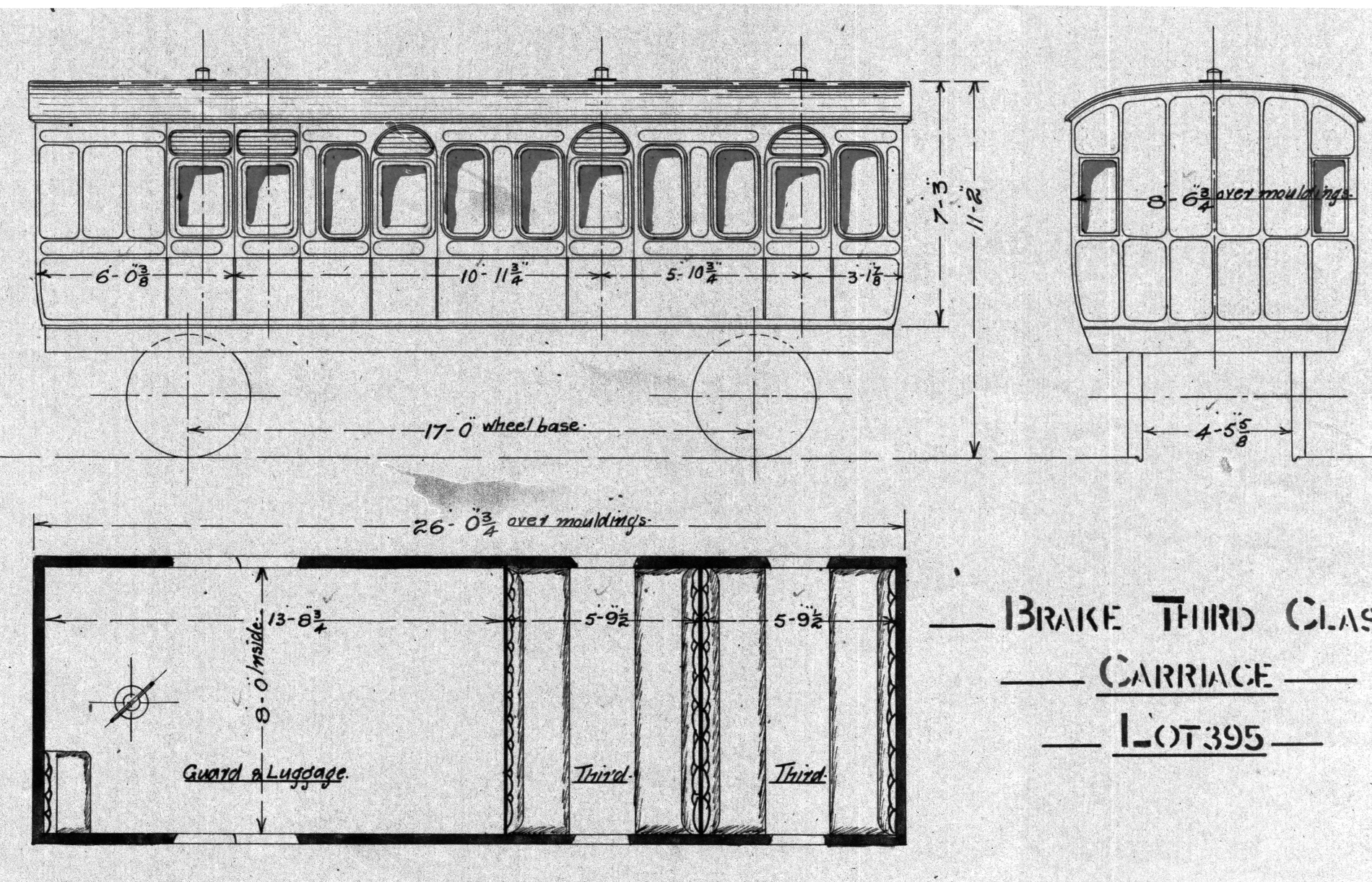 Note that the drawing is based upon just the first built coach that was converted from T7 (no.273). All the others retained panels around the double doors like T9.
|
437 to brake workman's in early 1930s | 276 - 1931 229, 262, 273 - 1932 226 - 1933 296 - 1936 437 - 1937 488 - 1938 |
3 compartment brake second 4 wheels | 26' x 8'6" 17' |
2 built in 1889 | 28, 31 |   |
BS ==> BT 28 ==> 309 - 1897 31 converted to T6 in 1896 |
309 - 1936 |
4 compartment brake third 4 wheels | 26' x 8'6" 17' |
1 built in 1887 | 704 |   |
704 converted to T8 | |
3 compartment brake third 4 wheels | 26' x 8'6" 17' |
6 built in 1888 2 built in 1889 2 built in 1889 1 built in 1894 |
54, 800, 1043, 1370, 1671, 1672 155, 1200 387, 399 2628 |
  |
1671/2 were renumbered to 2671/2 in 1895
54, 155, 387, 399, 1200, 2628, 2671, 2672 converted to T5 |
1043 - 1910 1370 - 1932 800 - 1934 |
1 built in 1887 6 converted from S18 around 1898 1 converted from lot 396c |
777 316, 710, 787, 792, 1049, 1334 704 |
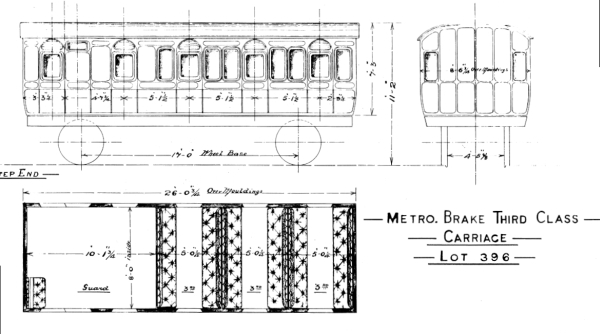  Note I'm not convinced by the accuracy of this drawing as it shows that the van space has been converted from a compartment. The only coach built on lot 396 with 4 compartments was never allocated a diagram number,
whilst the other brake coach built on this lot had 3 compartments and I suspect was not built with a psuedo door as shown, but with proper panels.
|
777 converted to T5
316 was noted as being painted brown in 9/1933 |
787 - 1930 792 - 1931 704, 710 - 1932 1334 - 1935 316, 1049 - 1937 |
3 compartment brake second 4 wheels | 26' x 8'6" 17' |
6 built in 1888 2 built in 1889 2 built in 1889 1 built in 1894 |
12, 24, 26, 27, 29, 38 30, 33 37, 40 80 |
 
|
BS ==> BT 12 ==> 457 - 1899 37, 40, 80, 226, 262, 296, 437 converted to T6 between 1896 and 1912 286 to brake workman's in early 1930s |
457 - 1932 286 - 1933 228 - 1937 239 - 1940 |
3 compartment brake third | 28' x 8'6" 19' |
2 converted from T17 | 301, 322 |  Conversion from T17 to T15 involved expanding the guards/luggage area by including the adjacent compartment. The door was locked shut, handles removed and windows barred.
 |
||
3 compartment brake second |
1 converted from T17 | 5081 |  Conversion from T17 to T16 involved expanding the guards/luggage area by including the adjacent compartment. The door was locked shut, handles removed and windows barred. |
Renumbered to 1672 in 1907 and allocated to the Bala And Blaineau Train | 1672 - 1940 | |
4 compartment brake second/third | 28' x 8'6" 19' |
Brake seconds 1 built in 1893 1 built in 1895
Brake thirds 1 built in 1893 1 built in 1895 |
44 81 301 322 |


|
301 & 322 to T15
81 to T16 | 352 (ex 5044) - 1916 |
3 compartment brake third | 31' x 8'6" 19' |
1 converted from T59 | 312 |  Conversion involved expanding the guards area by including the two adjacent compartments. The compartment doors were locked shut, handles removed and windows barred to make a luggage area. |
||
3 compartment brake third/second with 48 seats |
11 converted from T59 | 2nd class no.-> 3rd class no.
66 -> 794, 71 -> 1671, 102 -> 2611, 103 -> 892, 104 -> 924, 105 -> 2667 313, 2621, 2626, 2699, 2700 |
2699 converted to 179 Wagon Repairers & Examiners Cabin | 2626 - 1932 2700 - 1933 1671 - 1934 794 - 1935 892, 2621 - 1938 2667 - 1939 2611 - 1940 |
||
3 compartment brake third/second with 3 seats in the guards luggage area |
2 converted from T59 in 1906 | 116 -> 338, 2698 | 2698 - 1948 | |||
4 compartment brake third with 11 seats in the guards luggage area |
11 converted from T59 | 317, 334, 337, 2622, 2624, 2625, 2627, 2693, 2694, 2695, 2696 |  Conversion involved expanding the guards area by including the adjacent compartment. The compartment door was locked shut, handles removed and windows barred to make a luggage area. |
2622, 2696 - 1932 2624, 2625, 2695 - 1936 2627, 2694 - 1937 2693 - 1938 |
||
4 compartment brake third/second with 8 seats in the guards luggage area |
4 converted from T59 | 115, 253, 628, 694 | ||||
5 compartment brake third |
6 built in 1893 1 built in 1894 4 built in 1896 in 2 batches 2 built in 1897 7 built in 1898 in 3 batches |
2621 to 2626 2627 2693, 2694 2695, 2596 2697, 2698 313, 2699, 2700 312, 317 334, 337 |

Right hand side
|
The chassis of 2695 was given a new body in 1898 after an accident at Paddington
312 to 3 compartment brake third T54 66, 71, 102, 103, 104, 105, 313, 2621, 2626, 2699, 2700 to 3 compartment brake third T55 116, 2698 to 3 compartment brake third T56 317, 334, 337, 2622, 2624, 2625, 2627, 2693, 2694, 2695, 2696 to 4 compartment brake third T57 115, 253, 628, 694 to 4 compartment brake third T58 69, 70, 72, 89 to 92 to 5 compartment brake third T60 |
2697 - 1903 2623 - 1932 |
|
5 compartment brake second later converted to third class |
6 built in 1893 1 built in 1894 4 built in 1896 in 2 batches 2 built in 1897 7 built in 1898 in 3 batches |
66 to 71 72 89, 90 91, 92 101, 102 103 to 105 116, 117 118, 119 |
||||
5 compartment brake third with 8 extra seats in the guards luggage area |
7 converted from T59 between 1901 & 1912 | 69 -> 364, 70 -> 365, 72 -> 366, 89 -> 367, 90 -> 369, 91 - 423, 92 -> 373 |
366 converted to Tool Van 43968 | 364, 365 - 1932 423 - 1934 |
||
ex U1 no diagram number 4 compartment workmen's third | 25' x 8'6 16' |
3 converted from R3 in 1932 & 1933 3 converted from U1 |
688, 698, 702, 707, 714, 718 | 
| 707 converted in 1940 to Pilot Van 74 and used in the Lydney breakdown train - see adjacent photograph | 714 - 1935 718 - 1936 698, 702 - 1938 688 - 1949 |
no diagram number 4 compartment third | 26' x 8'6 17' |
1 converted from R5 in 1898 | 2354 |  | U2 in 1898 | |
ex U2 no diagram number 4 compartment workmen's third | 26' x 8'6 17' |
4 converted from R5 4 converted from U2 |
600, 607, 620, 662, 687, 709, 710, 712 |  | None | 600 - 1931 620 - 1932 709, 710, 712 - 1933 607, 662 - 1934 687 - 1936 |
| 25' x 8'6 16' | 5 converted from R3 | 110 to 112, 114, 116 | 
|
6112, 6113, 6116 to Workmen's Third in 1933(x2) and 1936 respectively | 6110 - 1932 6111 - 1935 |
|
| 26' x 8'6 17' | 2 converted from R4 in 1897 18 converted from R5 between 1896 and 1899 1 converted from Third in 1889 |
6, 7 1, 10, 53, 57, 133, 139 to 142, 169, 173, 189, 195, 291, 303, 305, 309, 312, 313 143 |

|
6001, 6057, 6141, 6133 to Workmen's Third in 1930 to 1932 | 6142 - 1930 6303, 6313 - 1931 6140, 6143, 6007, 6010, 6053 - 1934 6006, 6305, 6309 - 1935 6291 - 1936 6139, 6189, 6195 - 1938 |
|
5 compartment composite Built with 2x 1st and 3x 3rd compartments 4 wheels | 28' x 8'6" 19' |
6 built in 1893 1 built in 1894 4 built in 1896 in 2 batches 5 built in 1897 in 2 batches 4 built in 1898 in 2 batches |
1811 to 1816 1817 1878, 1879 1882, 1883 1884, 1885 1886 to 1888 1889, 1890 1891, 1892 |

7885 was first converted to a camping coach 9998 and then used in departmental use |
1812 to S19 in 1902 7878, 7879, 7882, 7883, 7886, 7887, 7889 to Workmen's Thirds in 1932 to 1937 7885 to Camping Coach 9998 in 1931 |
7891 - 1931 7815, 7884, 7888, 7892 - 1932 7816 - 1933 7890 - 1934 7811, 7814 - 1936 7813, 7817 - 1937 |
4 compartment composite
| 24' x 8'6" 15' |
2 converted briefly from S16 in 1910 | 6197 & 6224 |  2x 2nd class compartments & 2x 3rd class compartments |
S16 | None |

















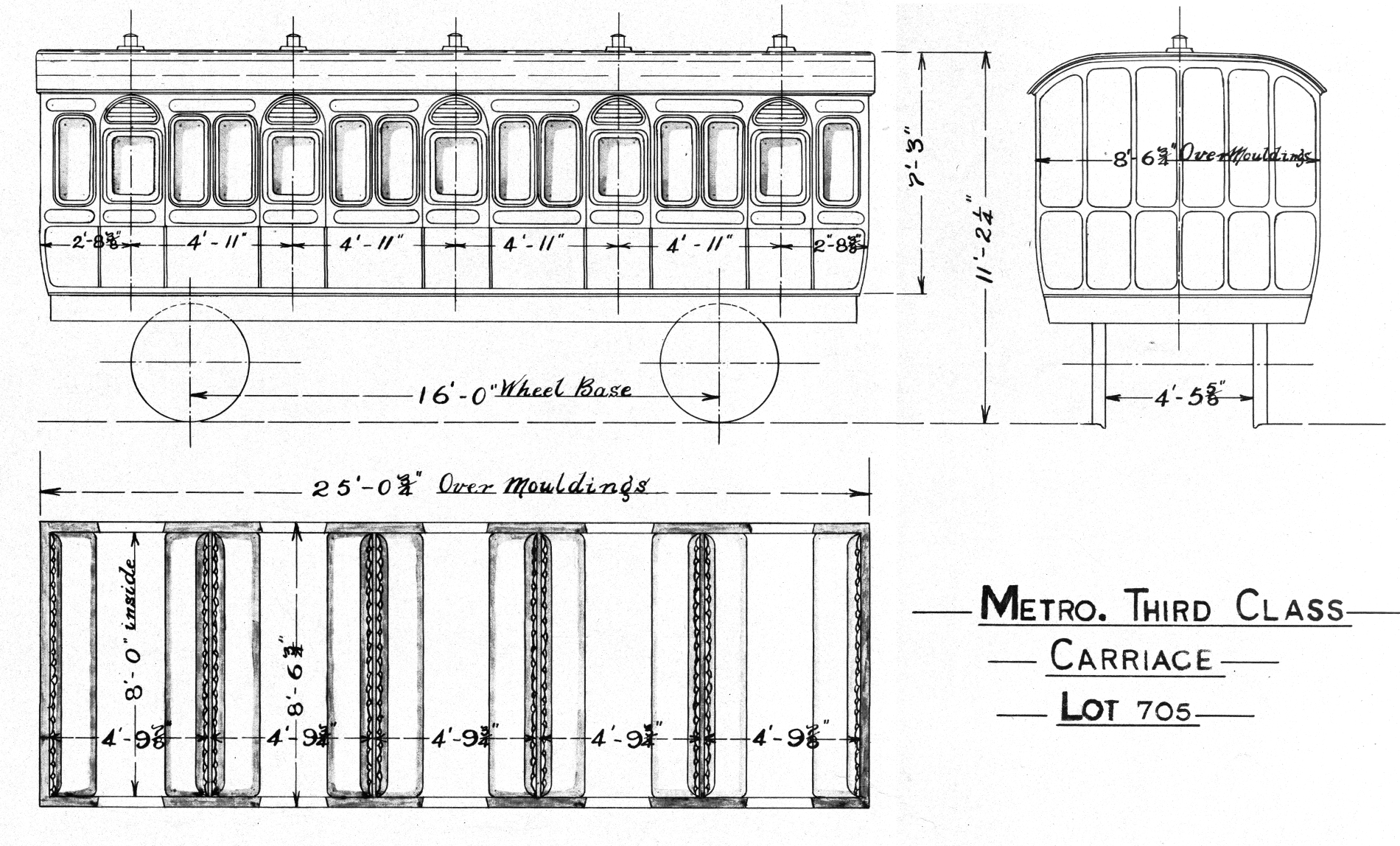
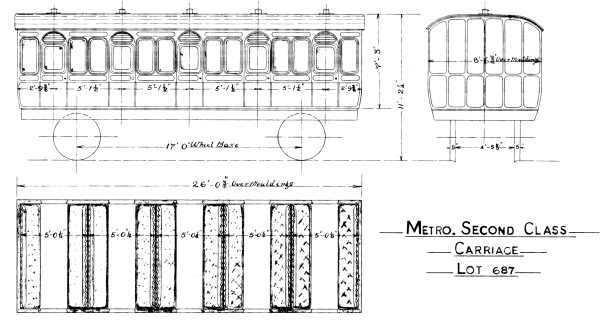








-LGRP-17559-Stourbridge-Junc-1924.jpg)
-LGRP-17559-Stourbridge-Junc-1924.jpg)









